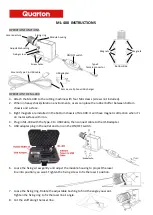
Cylinder pressure of 300 bar flows through the anti-debris tube containing a
sintered bronze filter and through the cylinder valve at a 90º angle into the
pressure reducer which reduces velocity.
The HP side of the system is protected
by a choke screw that restricts the
airflow to a maximum of 25 l/min if
damage to supply hose occurs.
HP air enters the reducer, closes and
seals the piston of the whistle activation
mechanism against the seat. This
pressurises the capillary tube in the
dual pressure hose and activates the
pressure sensor of the Bodyguard
®
-
turning ‘On’ the unit - passes into the
piston bore - past the piston seat and
pre-set plunger and into the MP chamber.
As air is deflected across the plunger
it is reduced to 6-9 Bar (passes from
a small area to a larger area).
As the pressure increases in the MP
chamber, it forces the piston to move
axially against the compression
spring until the piston seat contacts
the end face of the plunger - sealing
off the high pressure air.
On inhalation, from the LDV, the air
is drawn from the medium pressure
chamber and as the pressure reduces
in the chamber, the compression
spring retracts the piston - moving
the piston seat from the end face of
the plunger. The HP air then again
begins to enter the medium pressure
chamber - repeating the cycle.
Consumption of air from the
cylinder(s) reduces the available
pressure, and at a pre-set pressure
the compression spring in the whistle
activation mechanism retracts the
HP plunger from its sealing seat –
releasing air from the medium
pressure chamber and into the
whistle activation chamber.
A pressure relief arrangement is
incorporated in the pneumatics
system at the MP outlet from the
reducer. In the unlikely event of an
HP leak into the MP side of the
system, causing an ‘over pressure’,
the relief valve will open between
11bar - 16bar to vent pressure
This safety feature ensures that MP
air is maintained to the LDV and
subsequently to the wearer.
When the wearer begins to inhale a
negative pressure is created inside
the facepiece and lung demand valve.
-1 to -25 bar. Due to the negative
pressure the ambient air pressure
acts against the diaphragm. As the
diaphragm deflects it then presses
against the main hinged lever of the
balanced piston unit resulting in the
release of the positive pressure
‘Off’ mechanism.
Flow of Air
Extended Duration Breathing Apparatus (EDBA) Instructor Reference Guide - February 2018, Version 1.0
@
NARU_Education
www.narueducationcentre.org.uk
D
R
Ä
G
E
R
(
P
S
S
)
7
0
0
0
1.0
NH
S
A
M
BU
LANCE S
E
R
V
IC
E
B A I G U I D E
N A R U E D U C A T I O N C E N T R E
07






































